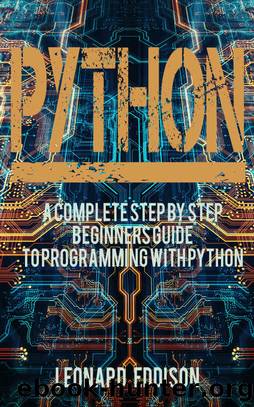Python: A Complete Step By Step Beginners Guide To Programming With Python by Leonard Eddison

Author:Leonard Eddison [Eddison, Leonard]
Language: eng
Format: epub
Published: 2017-04-19T07:00:00+00:00
Chapter 7:
Python’s Methods
There is a lot of stuff that you can do while you are using Python. The majority of things that you do will actually be very complicated and not at all like the simple strings that you have put together throughout the chapters of this book. Be aware that they will be somewhat complicated and that you will need to work with different things to be able to get each of the strings done.
With functions, you would generally need to copy and paste every single line of information that you have into the file that you want to be able to show to people. Methods eliminate this problem and allow you the chance to be able to put the codes to good use instead of spending a long time trying to get it to all fit in.
The actual term method refers to the following:
returndata type with a functionName in it
you will then need to put
retrun value (not all functions need this part of the code though)
You can do this to create a function depending on the numbers that you want to be able to use:
multiplyNum(number){return number* ; }
You can also create this to get the number input that you want to go into that multiplication sequence:
main {x = multiplyNum (6); }
The function that goes into the equation is the f(x) which is similar to many different things that you may have seen in various math classes throughout your life – further proving that programming and the idea behind Python all goes back to math and what math is able to do in a sense of computing. It all relates back to what you can do with different math equations.
Since you are using Python though, you can easily understand the way that methods work. They are nearly identical to the options that you have with different codes, but Python has made it much easier for you to understand the information that is included with each of these options.
To define a function in Python, all you have to do is let Python know that you are creating a method (which is the exact same thing as a function):
def functionName(arguments):
# code here
The next step of functions is to start working with functions on your own. Create your Chapter 7 file by saving it as ch7.py.
After you have created the file, you are going to use it to make a size calculator for your home. It will allow you to put the square footage of the home in, and it will give you an idea of the size of your hypothetical home. You are going to have completely perfectly square rooms in your “home” for the purpose of this file:
rooms = []
Now, you will need to create the method that is necessary for figuring out what the area of the home is going to be:
def calculateArea(length, width):
print”/nRoom square footage: %d” % (length * width) return length * width
The function for the room will be as follows:
def addRooms(roomlist):
sqareft: 0
The next step is using
Download
This site does not store any files on its server. We only index and link to content provided by other sites. Please contact the content providers to delete copyright contents if any and email us, we'll remove relevant links or contents immediately.
| Ada | Ajax |
| Assembly Language Programming | Borland Delphi |
| C & C++ | C# |
| CSS | Compiler Design |
| Compilers | DHTML |
| Debugging | Delphi |
| Fortran | Java |
| Lisp | Perl |
| Prolog | Python |
| RPG | Ruby |
| Swift | Visual Basic |
| XHTML | XML |
| XSL |
The Mikado Method by Ola Ellnestam Daniel Brolund(20293)
Hello! Python by Anthony Briggs(19619)
Secrets of the JavaScript Ninja by John Resig Bear Bibeault(17890)
The Well-Grounded Java Developer by Benjamin J. Evans Martijn Verburg(17296)
OCA Java SE 8 Programmer I Certification Guide by Mala Gupta(17208)
Kotlin in Action by Dmitry Jemerov(16849)
Algorithms of the Intelligent Web by Haralambos Marmanis;Dmitry Babenko(15991)
Grails in Action by Glen Smith Peter Ledbrook(15158)
Sass and Compass in Action by Wynn Netherland Nathan Weizenbaum Chris Eppstein Brandon Mathis(13111)
Test-Driven iOS Development with Swift 4 by Dominik Hauser(10312)
Windows APT Warfare by Sheng-Hao Ma(7832)
Layered Design for Ruby on Rails Applications by Vladimir Dementyev(7544)
Blueprints Visual Scripting for Unreal Engine 5 - Third Edition by Marcos Romero & Brenden Sewell(7447)
Solidity Programming Essentials by Ritesh Modi(4558)
Hands-On Full-Stack Web Development with GraphQL and React by Sebastian Grebe(4423)
Functional Programming in JavaScript by Mantyla Dan(4419)
WordPress Plugin Development Cookbook by Yannick Lefebvre(4378)
Unity 3D Game Development by Anthony Davis & Travis Baptiste & Russell Craig & Ryan Stunkel(4266)
The Ultimate iOS Interview Playbook by Avi Tsadok(4249)
